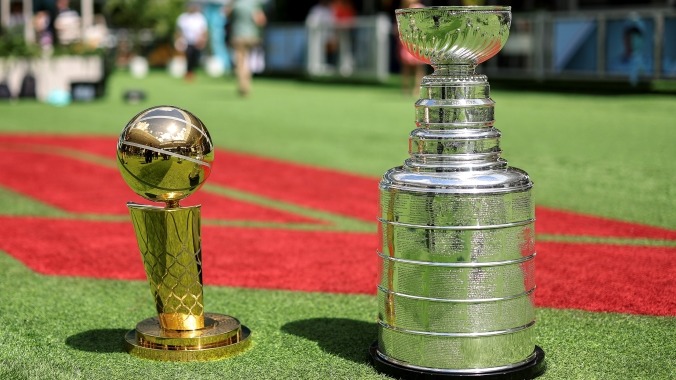Some may laugh at this title as a desperate attempt to connect three current events before we enter the sports lull of a never-ending summer of baseball, but if you read to the end of this blog, you will be forced to agree with the obviously true conclusions that my highly developed sports knowledge has led me to. Some may call me fodder for this insensitive exchange, but the truth is that I have watched enough hours of each sport to know the truth, and anyone who disagrees is just not as smart as me. Truly, I sympathize with you.
Some of you may be incoherently saying, “But Jacob, one sport is played with hands, another is forbidden, and a third is played with a funny stick.” You are country bumpkins. You are complete fools. This is the definition of not seeing the forest for the trees. If you open your third eye and look deeply into the nature of each sport, you will experience a revelation that will bring you to the same empirically correct position as me.
Let's take a moment to be serious and not joke around for a second: basketball, hockey, and soccer are arguably the same sport from a fundamental philosophical standpoint: teams work together to put an object in a goal while the other team tries to stop it. While the playing field and the details of the rules differ, the fundamental dynamics remain the same, which leads to some surprisingly similar tactics and strategies in all three sports.
All three teams use the same basic defensive tactics as their organizing principle. While this dynamic has changed somewhat as basketball has moved from the days of two big men and three wings to a one-in, four-out style, the basic principle remains the same: position two big players next to the goal to prevent the other team from scoring. Most soccer formations include two center backs, while hockey is more of a line-up with two defensemen protecting the goal and three forwards attacking. Meanwhile, the Minnesota Timberwolves proved this year that the best defense in the NBA is still to position the two biggest players next to the ring.
On the offensive side, there is much more variation as the characteristics of each sport affect tactics, but so do the basic offensive formations. Whether it's the famous Spanish tiki-taka style, the Edmonton Oilers' unstoppable power play, or Phil Jackson's triangle offense, the formation where the ball/puck handler has two direct outlets on either side is a very common and effective tactic in all three sports.
“Okay, Jacob, you're right, but the same sport? You've got to be kidding me.”
Again, I cannot help but pity you small-minded sports fans who allow old-fashioned materialism to blind them to the shared spirit of these beautiful games. SprinterLionel Messi smiles when Nikola Jokic, the official athlete of the NBA, finds a free player to cut toward the net. Every time Connor McDavid, the rightful winner of the Conn Smythe Trophy, confuses a defender yet again and scores, Stephen Curry can't help but reach his hand out of the air and bump fists with McDavid in solidarity.
At the most granular level, all team sports share the same dynamics that generally emphasize creating space in an effective manner. Football's play-action play most vividly illustrates this principle: the fake handoff to the running back is designed to draw the linebacker and safety to the line of scrimmage, creating space for the receiver to run into the vacant space behind them. The triangle as a fundamental offensive organizing principle across basketball, hockey, and football not only reinforces its role as a foundational aspect of engineering, but also attempts to achieve the same objective as the play-action pass: to move the defender out of the space the offense wants to move into.
Sports are a universal language. Soccer spread across the globe due to both colonialism and its simple rules and low cost of play. Basketball followed suit, establishing itself as a truly global game in the American century. Hockey will always be prohibitively expensive due to the equipment, making it less likely to take the world by storm like soccer, but the fact that it has spread to nearly every corner of the globe proves that it follows the same universal principles that underpin the popularity of basketball and soccer.
In conclusion, I accept my apologies to all readers. I know this title seems designed to annoy readers, but the logic presented is so obviously true that I can only assume that everyone reading this will wholeheartedly agree with me. Football, basketball and hockey are the same sport, and anyone who thinks otherwise needs to open their third eye.

